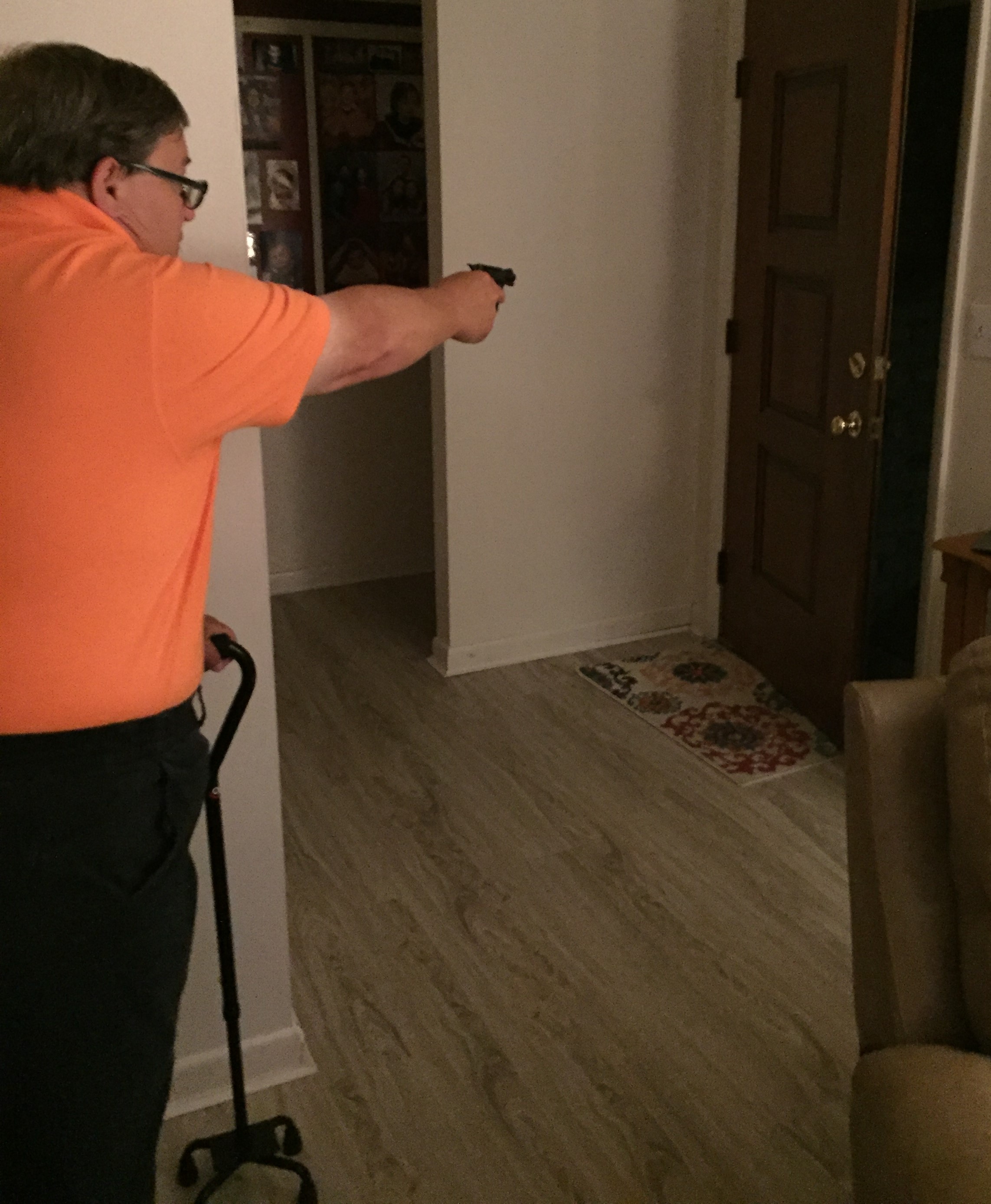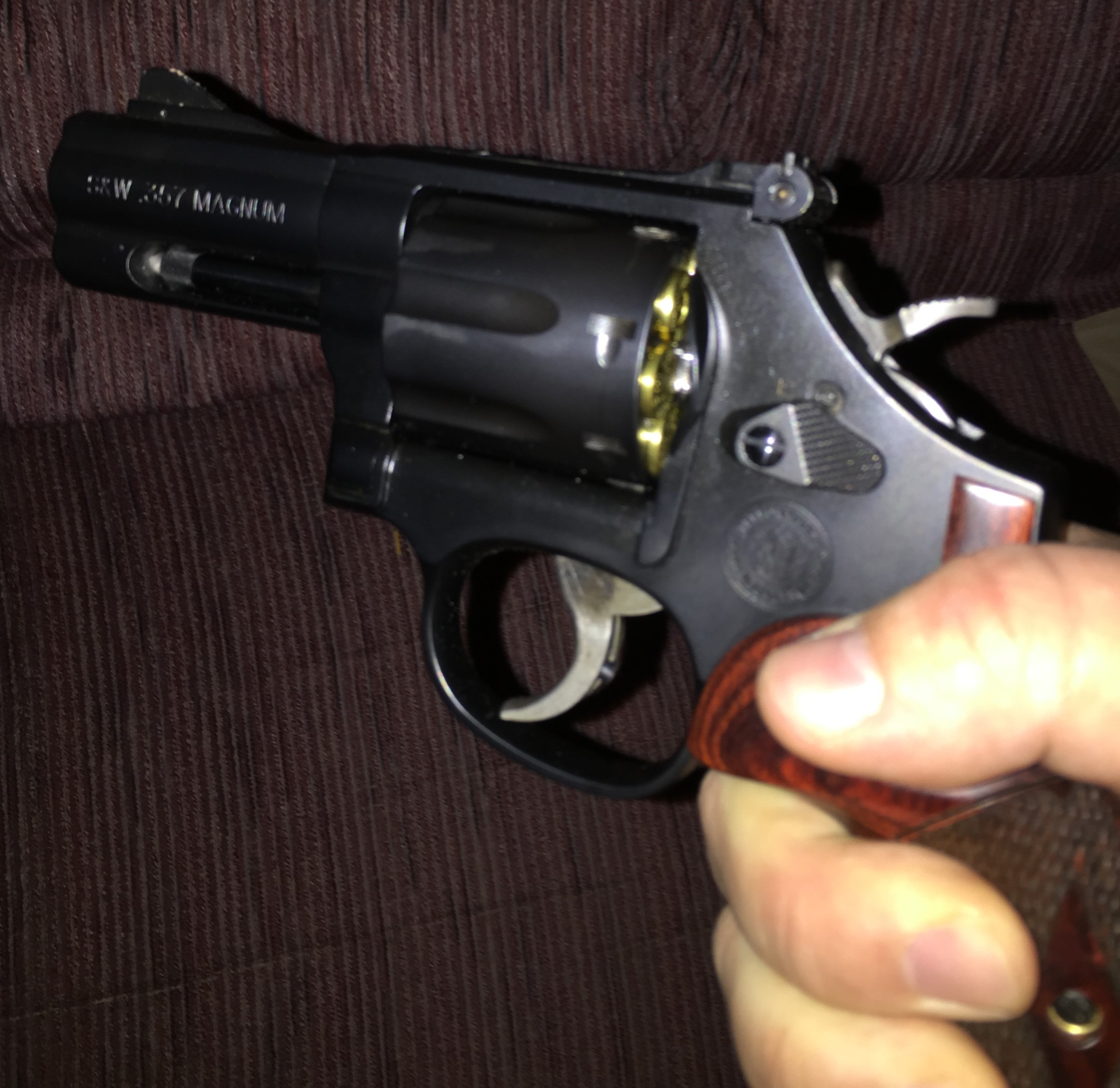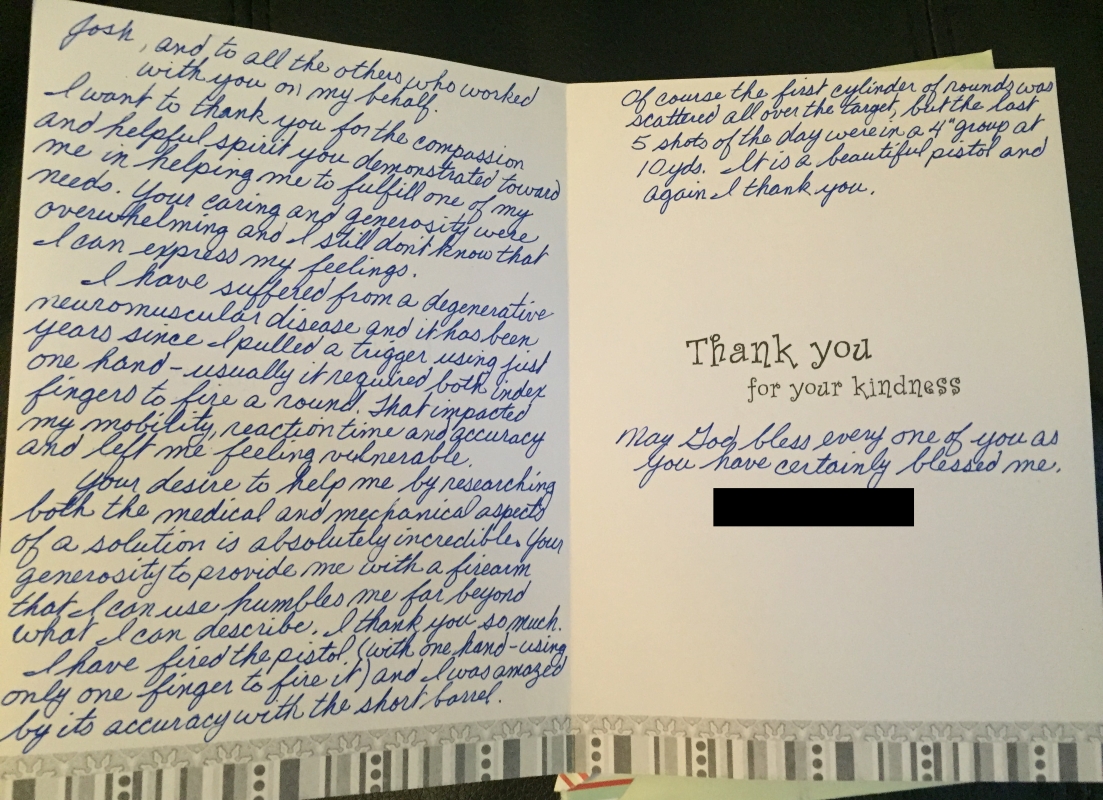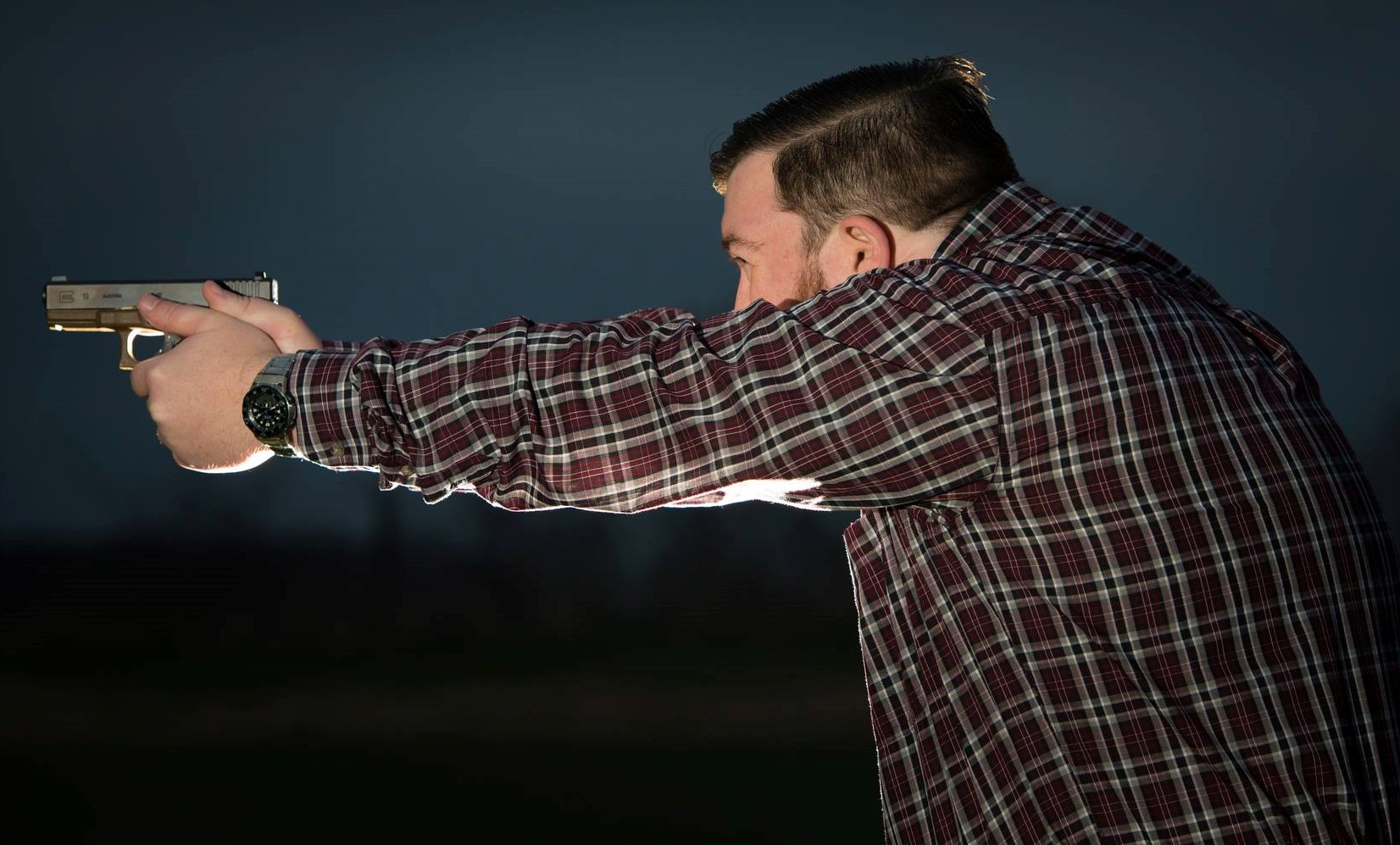
Even with shaky hands from Parkinson’s, by driving the gun out to full extension, the shooter gets a better kinesthetic alignment. This limits the shaking in his shooting hand. Photo: author
A family friend recently asked if I could help him with a shooting issue he was having. I had known for quite a while that his health had been poor and he had been in and out of the hospital. Though I didn’t know the details, I could tell this was something that had really been bothering him and that he was reaching out to me as a last resort.
He explained that for the past few years he had been suffering from a degenerative neuromuscular disease. As it had progressed, it had all but prevented him from being able to fire his defensive firearm. He was unable to pull the trigger without using two fingers (and even that was a struggle). Even loading magazines was too difficult. This new disability had left him feeling helpless and dependent on others for his and his family’s safety.
Disabled Shooting Challenges
Thinking about his situation, I imagined how I would feel if I were in his shoes. This man is a Vietnam veteran who has been a responsible firearms owner all his life, has trained and practiced his skills so he could protect his family from those who might want to harm them. Now he is faced with a disease that’s preventing him from doing all that.
I felt the need to help him but didn’t know where to begin. I told him to give me a few days and left him with this: “I won’t give up on you if you don’t give up on yourself.”
I immediately contacted a former student who is an orthopedic surgeon at a medical center in southern Indiana. He generously gave me some time out of his busy schedule to run through an in-depth explanation of the issues with this particular type of degenerative neuromuscular disease. After a little more research and information gathering, it was determined that my friend’s finger and hand muscles are fatiguing rapidly and preventing him from pulling the long, heavy trigger on his existing firearm.

Sometimes trigger work by a professional gunsmith is required to make a firearm work for you.
Photo: author
Mechanical Solutions
I spoke to a few gunsmiths and found that the particular handgun my friend was using has a trigger that progressively stacked weight until the gun went bang. This particular gun reached a little over 12 pounds before it fired. Unfortunately, there are no viable aftermarket triggers for this gun, so I began researching other possible solutions.
I realized if the trigger was stacked heavier on the front end and lighter after that, it might allow his finger to avoid fatigue during the trigger stroke. After speaking to a few people about the range of adjustability in different guns, it was clear that a revolver was going to be the best solution for this situation. Not only would it solve the trigger issue, it also solved his problem of not being able to reload his own magazines.
My super-talented gunsmith, Jordan Jackson at Black Bullet Firearms, was able to do exactly what needed to be done with an S&W Model 442 revolver he had available. He did an excellent job on the gun and smoothed it out to where it stacked at the beginning and lightened up at the end. Due to donations from some very generous friends and family, we were able to gift the gun to this gentleman, ship it to his local FFL, and pay for the transfer.
When I returned from the NRA Annual Meetings, this card had been delivered to me. It says:
Training Solutions
Friends, I am afraid many defensive firearms instructors have failed our elderly and disabled comrades. These potential students are not going to take a class where they have to complete an archaic FBI qualification course that requires people to shoot from kneeling at 25 yards. Many of these people would be hard-pressed to get to a kneeling position. And if they got there, getting up would be a real issue.
As instructors, it is our job to prepare them for self-defense within the constraints of their abilities. Not everyone needs to be trained to the standard of our FBI Special Agents. We don’t need to be putting shot timers on Grandma and telling her she has to kneel and shoot at implausible distances in 15 seconds. Does she fail if she does it in 16 seconds? That’s just absurd!
It is now abundantly clear to me that we are failing a large portion of our demographic. The baby boomers are getting older. Men and women are coming back from a decade of war. We have an obesity epidemic affecting a large percentage of our population. Do those people not deserve to be taught to defend themselves to the best of their abilities? Think about it. The self-defense industry as a whole seems to target 20- to 40-year olds, able to go rolling in the mud and complete FBI level tactical training.
Disabled shooting is not an oxymoron. If you are one of the many among that group of people—like me, who has the knees and back of an 80-year-old at the age of 37—you are not alone. You don’t have to feel vulnerable. Reach out to instructors who get it!
If I can help you, please feel free to e-mail me at jgideon@nosofttargets.com. Just because you’re not in peak physical condition doesn’t mean you have to be helpless. You can also find qualified instructors who want to help right here on the Personal Defense Network.



You brought my awareness out. Thank you
Hello. I am a disabled vet with a very very bad right hip. Extremely weak. I am right handed. Shot the M16A2 in the Army. New to hand guns. I got a Ruger LCP MAX 380. I want to know if you could give me advice on which of the five or so main standing shooting positions would be best...where my bad hip is on the same side of my body as my dominant hand. I read about placing my left leg a half step forward, and both feet about shoulder space apart. I am not sure. If you can't help, perhaps send me a link? PS there is actually a lot of recoil to this. I naturally put more weight on my left leg/hip to take pressure off my right leg/hip. So...balance is an issue as well. Thank you.
To be honest, I haven't read all the 130+ entries, but I do have a suggestion that appears to have been overlooked: Occupational therapist's evaluation and management. These professionals' job description is evaluating one's unique disabilities, then prescribing tools and training to accomplish whatever physical goals one wants, within the limits of what's possible. Of course, the therapist must be sympathetic to firearms use, but most, regardless of how they feel, will make good analyses and give good advice. This sore of problem is right in the OT's wheelhouse.
Thank you for writing about this. Being an RSO at a public range, I see a lot if issues that people have with limited mobility customers. Unfortunately more often than not, the gun store clerk just sells another DAO revolver to a person, who can't operate it efficiently. I recently had to help my Aunt who lost her husband of over 50 years last year as she was concerned since they were the victims of a home invasion which scared her. She has arthritis which limits her hand strength and movement. Her husband had left a revolver which she couldn't pull the trigger on. I went looking for the right firearm and it opened me up to another world I thought I was prepared for. I finally got her out to the range and found a good firearm for her to keep at the ready. There were some I thought for sure she would be able to shoot well and they proved to be not so good for one reason or another. She settled in very well with the SR22. 50 shots on paper and she was done for the day. It takes patience and thinking outside the box. Putting yourself in their shoes really helps. I used tape on my fingers to understand the limiting effects. Keep up the good work and I will look forward to keep reading!
It was so nice to read this article and see that someone is thinking about those of us who are no longer functioning at 100%. I had a fall off a ladder in 2010 onto concrete. I injured my cervical and lumbar spine in addition to shattering my left humerus. I have problems with balance related to the injuries and arthritic changes which just get worse with age and definitely create problems getting up and down. My grip strength is decreased due to peripheral neuropathy related to spinal injuries. It would be wonderful to have workshops that address physical issues and ways to overcome these and learn ways to compensate for physical losses. I am a retired psychiatrist who devoted much of my time to working with disabled veterans. For individuals with PTSD, the impairment in the ability to protect themselves and family can cause an increase in some symptoms of PTSD and these issues are certainly not addressed at the VA. In fact, veterans may be reluctant to even discuss any issues like this or secondary depression or anxiety for fear of losing the right to possess firearms legally. I applaud you for addressing these issues for the elderly and disabled, particularly for our veterans.
Thank you. As someone with a disability that's getting worse, at times rapidly, I know what my limitations are. Adapting drills within the limits of my range of motion, gets me some funny looks at the range, until I explain why. It's good to see some instructors finally getting the idea that adaptation isn't necessarily a bad thing, and that it actually individualizes the instruction for the student, and in a way that allows them to keep their pride. How I wish I could turn back the clock to when I was in peak physical condition, but wishing gets you nowhere, the reality is what we have to adjust too. Thanks for an encouraging article.
Thanks. I've got the problem and would like to address firearm skills thar would benefit.
"BRAVO ZULU" to all at PDN for their service and vital assistance to the 2A community. While not disabled at 84 yrs; that day may be my portion in the future. Gratifying to realize options are available. GOD Bless you and the USA!!
I have als and have the same problem in the story . I have a good friend that is a gun smith and a veteran from Iraq and afghan he been helping me a lot with this problem . Hard when you are in a wheelchair . God bless are veterans
I had a stroke I’m paralyzed on one side I wanna lern to handle a firearm to protect myself